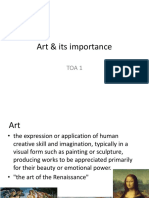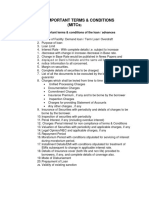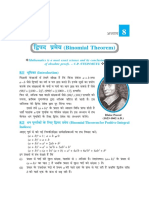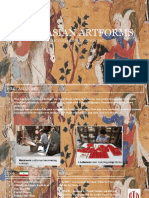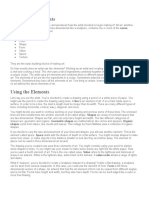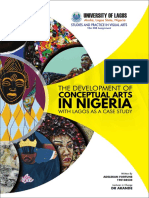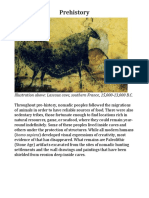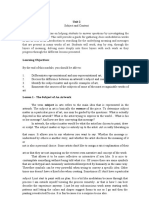The Living Art Traditions of India
The Living Art Traditions of India
Uploaded by
busuuuOriginal Description:
Original Title
Copyright
Available Formats
Share this document
Did you find this document useful?
Is this content inappropriate?
Report this DocumentCopyright:
Available Formats
The Living Art Traditions of India
The Living Art Traditions of India
Uploaded by
busuuuCopyright:
Available Formats
The Living Art Traditions of India 8
T here has always been a timeless tradition of art forms,
which have been practised for different reasons among
people, living far from urban life in interior terrains of forests,
deserts, mountains and villages. So far, we have studied art
of a certain time, a period named after a place or dynasties,
who ruled different parts of the Indian subcontinent for few
hundred years or so. But what about common people? Were
they not creative? Was there no art that existed around them?
From where did the artists come to the courts or patrons?
What did they use to make before coming to cities? Or even
now, who are the unknown artists making handicrafts in
faraway deserts, mountains, villages and rural areas, who
have never been to an art school or design institute or even
attended formal schooling?
Our country has always been a repository of indigenous
knowledge, which has been transferred from one generation
to another. Artists in each generation have created the best
of works out of available material and technology. Many
scholars named these art forms as minor arts, utility art,
folk art, tribal art, people’s art, ritual art, crafts, and so
on. We know that these art forms have existed from time
immemorial. We have seen the examples in pre-historic
cave paintings or works of pottery, terracotta, bronze, ivory,
etc., of the Indus period as well. During the early history
and its subsequent times, we find references
of artists’ communities everywhere. They
made pots and dresses, jewellery and ritual
or votive sculptures. They decorated their
walls and floors and did many more artistic
things to fulfill their daily needs and supply
their works to local markets at the same time.
There is an instinctive aesthetic expression in
their creations. There is symbolism, specific
use of motifs, materials, colours and methods
of making. There is a thin line between art of
2020-21
1_8.LivingArt Traditions of India.indd 127 01 Sep 2020 03:00:57 PM
128 An Introduction to Indian Art —Part II
the people and crafts as both involve creativity, instinct,
necessities and aesthetics.
Even now, in many pockets, we find such artifacts. In
the nineteenth and twentieth centuries, a new perspective
emerged among modern artists when they looked at
traditional art forms around them as sources of inspiration
for their creative pursuits in India, as well as, the West. In
India, post-Independence a revival of handicraft industry
took place. The sector became organised for commercial
production. Apart from continued practice, it gained a
unique identity. With the forming of States and Union
Territories, each one of them showcased their unique art
forms and products in their respective State emporia.
The art and craft traditions of India showcase the tangible
heritage of the country with history of more than five
thousand years. Though we know many of these, let us talk
about few of them. By and large, there has been a religious
or ritualistic overtone with richer symbolism, utilitarian and
decorative aspects, associated with the day-to-day practices
at home to production on a large scale.
Painting Tradition
Among the many popular traditions of painting, Mithila or
Madhubani painting of Bihar, Warli painting of Maharshtra,
Pithoro Painting of North Gujarat and western Madhya
Pradesh, Pabuji ki Phad from Rajasthan, Pichhwai of
Nathdwara in Rajasthan, Gond and Sawara Paintings of
Madhya Pradesh, Pata Chitra of Odisha and Bengal, etc., are
few examples. Here, a few of them have been discussed.
Mithila painting
Among the most known contemporary painterly art forms is
Mithila art that derives its name from Mithila, the ancient
Videha and birthplace of Sita. Also called Madhubani painting
after the nearest district capital, it is a widely recognised folk
art tradition. It is presumed that for centuries, women living
in this region have painted figures and designs on the walls
of their mud houses for ceremonial occasions, particularly,
weddings. People of this area see the origin of this art form at
the time of Princess Sita getting married to Lord Rama.
These paintings, characterised by bright colours, are
largely painted in three areas of the house — central or outer
2020-21
1_8.LivingArt Traditions of India.indd 128 01 Sep 2020 03:00:57 PM
The Living Art Traditions of India 129
2020-21
1_8.LivingArt Traditions of India.indd 129 01 Sep 2020 03:00:59 PM
130 An Introduction to Indian Art —Part II
courtyards, eastern part of the house, which is the dwelling
place of Kuladevi, usually, Kali, and a room in the southern
part of the house, which houses the most significant images.
Various armed gods and animals or images of women at
work like carrying waterpots or winnowing grain, etc., are
vividly portrayed in the outer central courtyard. The inner
verandah, where the family shrine — devasthana or gosain
ghar is located, griha devatas and kula devatas are painted.
In the recent past, many paintings are done on fabric, paper,
pots, etc., for commercial purposes.
The most extraordinary and colourful painting, however,
is done in the part of the house known as the kohbar ghar
or inner room, where magnificent representations of kohbar,
a lotus with a stalk in full bloom having metaphoric and
tantric connotation along with images of gods and goddesses
are painted on freshly plastered walls of the room.
Among other themes that are painted are episodes from
the Bhagvata Purana, Ramayana, stories of Shiva-Parvati,
Durga, Kali and Rasa-Lila of Radha and Krishna. Mithila
artists do not like empty spaces. They fill in the entire space
decoratively with elements from nature like birds, flowers,
animals, fish, snakes, the Sun and the moon, which often
have symbolic intent, signifying love, passion, fertility,
eternity, well-being and prosperity. Women paint with
bamboo twigs to which some cotton swab, rice straw or fibre
is attached. In earlier days, they made colour from mineral
stones and organic things, such as phalsa and kusum
flowers, bilwa leaves, kajal, turmeric, etc.
Warli painting
The Warli community inhabit the west coast of Northern
Maharashtra around the north Sahyadri range with a large
concentration in the district of Thane. Married women play a
central role in creating their most important painting called
Chowk to mark special occasions. Closely associated with
the rituals of marriage, fertility, harvest and new season of
sowing, Chowk is dominated by the figure of mother goddess,
Palaghat, who is chiefly worshipped as the goddess of fertility
and represents the corn goddess, Kansari.
2020-21
1_8.LivingArt Traditions of India.indd 130 01 Sep 2020 03:00:59 PM
The Living Art Traditions of India 131
2020-21
1_8.LivingArt Traditions of India.indd 131 01 Sep 2020 03:00:59 PM
132 An Introduction to Indian Art —Part II
She is enclosed in a small square frame decorated with
‘pointed’ chevrons along the outer edges that symbolise
Hariyali Deva, i.e., the God of Plants. Her escort and guardian
is visualised as a headless warrior, riding a horse or standing
beside her with five shoots of corn springing from his neck,
and hence, called Panch Sirya Devata (five-headed god). He
also symbolises the guardian of the fields, Khetrapal.
The central motif of Palaghat is surrounded by scenes of
everyday life, portraying acts of hunting, fishing, farming,
dancing, mythological stories of animals, where the tiger is
conspicuously visible, scenes of buses plying and the busy
urban life of Mumbai as people of Warli see around them.
These paintings are traditionally painted with rice flour on
earth coloured walls of their homes. As mentioned earlier, are
painted to promote fertility, these paintings avert diseases,
propitiate the dead, and fulfill the demands of spirits. A
bamboo stick, chewed at the end, is used as the paintbrush.
Gond painting
Gonds of Madhya Pradesh have a rich tradition with their
chiefs ruling over Central India. They worshipped nature.
Paintings of Gonds of Mandla and its surrounding regions
have recently been transformed into a colourful depiction
of animals, humans and flora. The votive paintings are
geometric drawings done on the walls of huts, portraying
Krishna with his cows surrounded by gopis with pots on
their heads to which young girls and boys make offerings.
2020-21
1_8.LivingArt Traditions of India.indd 132 01 Sep 2020 03:01:00 PM
The Living Art Traditions of India 133
2020-21
1_8.LivingArt Traditions of India.indd 133 01 Sep 2020 03:01:03 PM
134 An Introduction to Indian Art —Part II
Pithoro painting
Painted by Rathva Bhils of the Panchmahal region in Gujarat
and Jhabua in the neighbouring State of Madhya Pradesh,
these paintings are done on the walls of houses to mark
special or thanksgiving occasions. These are large wall
paintings, representing rows of numerous and magnificently
coloured deities depicted as horse riders.
The rows of horse rider deities represent the cosmography
of the Rathvas. The uppermost section with riders represents
the world of gods, heavenly bodies and mythical creatures.
An ornate wavy line separates this section from the lower
region, where the wedding procession of Pithoro is depicted
with minor deities, kings, goddess of destiny, an archetypal
farmer, domestic animals, and so on, which represent
the earth.
2020-21
1_8.LivingArt Traditions of India.indd 134 01 Sep 2020 03:01:04 PM
The Living Art Traditions of India 135
2020-21
1_8.LivingArt Traditions of India.indd 135 01 Sep 2020 03:01:05 PM
136 An Introduction to Indian Art —Part II
Pata painting
Done on fabric, palm leaf or paper, scroll painting is another
example of art form practised in different parts of the country,
especially, Gujarat and Rajasthan in the West and Odisha
and West Bengal in East. It is also known as Pata, Pachedi,
Phad, etc.
Bengal patas comprise the practice of painting on cloth
(pata) and storytelling in regions of West Bengal. It is the
most receptive oral tradition, constantly seeking new themes
and formulating novel responses to major incidents in
the world.
The vertically painted pata becomes a prop used by
a patua (performer) for performance. Patuas, also called
chitrakars, belong to communities largely settled around
Midnapore, Birbhum and Bankura regions of West Bengal,
parts of Bihar and Jharkhand. Handling the pata is their
hereditary profession. They travel around villages, displaying
the paintings and singing the narratives that are painted.
Performances happen in common spaces of the village. The
patua narrates three to four stories each time. After the
performance, the patua is given alms or gift in cash or kind.
Puri patas or paintings evidently acquire their claim
to recognition from the temple city of Puri in Odisha. It
largely comprises the pata (initially, done on palm leaf
and cloth but now done on paper as well). A range of
themes are painted, such as the daily and festival veshas
(attires) of Jagannath, Balabhadra and Subhadra (e.g.,
Bada Shringar Vesha, Raghunath Vesha, Padma Vesha,
Krishna–Balaram Vesha, Hariharan Vesha, etc); Rasa
paintings, Ansara patti (this substitutes the icons in the
Garbhagriha, when they are removed for cleaning and fresh
colouring is done after Snanayatra); Jatri patti (for pilgrims to
take away as memorabilia and put them in personal temples
at home), episodes from the myths of Jagannath, such as
the Kanchi Kaveri Pata and Thia-badhia pata, a combination
of aerial and lateral view of the temple with the icons and
temples around or depiction of festivals around it.
2020-21
1_8.LivingArt Traditions of India.indd 136 01 Sep 2020 03:01:05 PM
The Living Art Traditions of India 137
2020-21
1_8.LivingArt Traditions of India.indd 137 01 Sep 2020 03:01:11 PM
138 An Introduction to Indian Art —Part II
Patachitras are done on small strips of cotton cloth, which
is prepared by coating the cloth with soft white stone powder
and glue made from tamarind seeds. There is a practice of
making the borders first. A sketch of the figures is, then, made
directly with a brush and flat colours are applied. Colours,
such as white, black, yellow and red are, usually, used. After
completion, the painting is held over charcoal fire and lacquer
is applied to the surface to make it water resistant and lend
sheen to it. The colours are organic and locally procured. For
example, black is obtained from lamp black, yellow and red
from haritali and hingal stone, respectively, and white from
powdered conch shells. Palm manuscripts are illustrated on
a palm variety called Khar-taad. Paintings on these are not
painted with brush but incised by a steel stylus, and then,
filled in with ink, and sometimes, tinted with paint. There
may also be some text accompanying these images. There
are questions on whether to consider the palm leaf tradition
a part of folk or sophisticated art as it has a lineage that
stylistically connects it to the mural and palm leaf traditions
of the eastern and other parts of the country.
Phads of Rajasthan
Phads are long, horizontal, cloth scrolls painted to honour
folk deities of pastoral communities inhabiting the region
around Bhilwara in Rajasthan. For such communities,
safeguarding their livestock is the foremost concern. Such
concerns purposely reflect in their myths, legends and
worship patterns. Among their gods are defied cattle heroes,
who are brave men who sacrificed their lives while protecting
the community’s cattle from robbers. Designated by the
broad term bhomia, these heroes are honoured, worshiped
and remembered for their acts of martyrdom. Bhomias, such
as Gogaji, Jejaji, Dev Narayan, Ramdevji and Pabhuji, have
inspired widespread cult following among the communities
of Rabaris, Gujjars, Meghwals, Regars and others.
Illustrating the valorous tales of these bhomias, the
phads, are carried by bhopas, the itinerant bards, who travel
the territory, displaying them while narrating tales and
singing devotional songs associated with these hero-deities in
night-long storytelling performances. A lamp is held against
the phad to illuminate images that are being spoken about.
The bhopa and his companion perform to the accompaniment
2020-21
1_8.LivingArt Traditions of India.indd 138 01 Sep 2020 03:01:11 PM
The Living Art Traditions of India 139
2020-21
1_8.LivingArt Traditions of India.indd 139 01 Sep 2020 03:01:12 PM
140 An Introduction to Indian Art —Part II
of musical instruments, such as ravanahattha and veena,
and employ the Khyal style of singing. Through the phads
and phad banchan, the community remembers the hero as a
martyr and keeps his story alive.
Phads, however, are not painted by the bhopas. They
have traditionally been painted by a caste called ‘Joshis’ who
have been painters in the courts of the kings of Rajasthan.
These painters specialised in court patronised miniature
paintings. Hence, the association of skilled practitioners,
bard musicians and court artists place phads higher than
other similar cultural traditions.
Sculptural Traditions
These refer to the popular traditions of making sculptures
in clay (terracotta), metal and stone. There are numerous
such traditions across the country. Some of them are
discussed here.
Dhokra casting
Among the popular sculptural traditions, Dhokra or metal
sculptures made from lost wax or cire perdue technique is one
of the most prominent metal crafts of Bastar, Chhattisgarh,
parts of Madhya Pradesh, Odisha and Midnapore in West
Bengal. It involves casting of bronze through the lost wax
method. The metal craftsmen of Bastar are called ghadwa.
In popular etymology, the term ‘ghadwa’ means the act of
shaping and creating. It is probably this that gives the casters
their name. Traditionally, the ghadwa craftsmen, besides
supplying the villagers with utensils of daily use also made
jewellery, icons of locally revered deities and votive offerings
in the form of snakes, elephants, horses, ritual pots, etc.
Subsequently, with a decrease in demand for utensils and
traditional ornaments in the community, these craftsmen
began creating new (non-traditional) forms and numerous
decorative objects.
Dhokra casting is an elaborate process. Black soil from
the riverbank is mixed with rice husk and kneaded with
water. The core figure or mould is made from this. On drying,
it is covered with a second layer of cow dung mixed with clay.
Resin collected from saal tree is, then, heated in a clay pot
till it becomes liquid to which some mustard oil is also added
and allowed to boil. The boiling liquid is, then, strained
2020-21
1_8.LivingArt Traditions of India.indd 140 01 Sep 2020 03:01:12 PM
The Living Art Traditions of India 141
2020-21
1_8.LivingArt Traditions of India.indd 141 01 Sep 2020 03:01:12 PM
142 An Introduction to Indian Art —Part II
through a cloth, collected and kept in a metal vessel over
water. As a result the resin solidifies but remains soft and
malleable. It is, then, taken apart in small pieces, heated
slightly over low burning coal and stretched into fine threads
or coils. Such threads are joined together to form strips. The
dried clay form is, then, overlaid with these resin strips or
coils and all decorative details and eyes, nose, etc., are added
to the figures. The clay form is, then, covered with layers —
first of fine clay, then, with a mixture of clay and cow dung,
and finally, with clay obtained from ant hills mixed with rice
husk. A receptacle is, then, made from the same clay and
fixed to the lower portion of the image. On the other side, a
cup filled with metal pieces is sealed with the clay-rice husk
mixture. For firing in the furnace, saal wood or its coal is
preferred as fuel. The cup, containing metal, is placed in the
bottom with clay moulds over it, and covered with firewood
and potshards. Air is blown continuously into the furnace for
about 2 to 3 hours till the metal turns into a molten state.
The moulds are, then, taken out with a pair of tongs, turned
upside down, given a brisk shake and the metal is poured
through the receptacle. The molten metal flows exactly into
the space once occupied by resin, which would by now have
evaporated. The moulds are allowed to cool and the clay layer
is hammered away to reveal the metal image.
Terracotta
The more ubiquitous sculptural medium prevalent across the
country is terracotta. Usually, made by potters, terracotta
pieces are votives or offered to local deities or used during
rituals and festivals. They are made from local clay found
on riverbanks or ponds. The terracotta pieces are baked for
durability. Whether it is Manipur or Assam in the North-East,
Kuchchha in Western India, Hills in the North, Tamil Nadu
in the South, Gangetic plains or Central India, there is a
variety of terracotta made by people of different regions. They
are moulded, modeled by hands or made on a potter’s wheel,
coloured or decorated. Their forms and purposes are often
similar. They are either the images of gods or goddesses. Like
Ganesh, Durga or the local deity, animals, birds, insects, etc.
2020-21
1_8.LivingArt Traditions of India.indd 142 08 Sep 2020 03:04:48 PM
The Living Art Traditions of India 143
2020-21
1_8.LivingArt Traditions of India.indd 143 01 Sep 2020 03:01:13 PM
You might also like
- Full Spectrum ColorDocument2 pagesFull Spectrum ColorAntony Bui33% (3)
- Blasting & Painting Report - FormatDocument2 pagesBlasting & Painting Report - FormatSenthil Kumaran100% (7)
- Black Pottery - Nizamabad (UP, India)Document53 pagesBlack Pottery - Nizamabad (UP, India)Naveen Singh86% (7)
- Mithila Madhubani Art PDFDocument21 pagesMithila Madhubani Art PDFShilpa Limje0% (1)
- Essex ManualDocument107 pagesEssex Manuali_tiberius_m8153100% (2)
- Spatharakis - The Portrait in Byzantine Illuminated ManuscriptsDocument220 pagesSpatharakis - The Portrait in Byzantine Illuminated ManuscriptsRAMO STEF SZEKERES100% (1)
- Culture and Heritage - Folk and Tribal Art - Know India - National Portal of IndiaDocument6 pagesCulture and Heritage - Folk and Tribal Art - Know India - National Portal of IndiarutujaNo ratings yet
- Chapter 1 - Introduction of The ProjectDocument57 pagesChapter 1 - Introduction of The ProjectPrabhu DevaNo ratings yet
- Craft VillageDocument14 pagesCraft VillageAnusha KothaNo ratings yet
- Madhubani Art: OriginDocument4 pagesMadhubani Art: OriginJawms DalaNo ratings yet
- Fashion MashupDocument23 pagesFashion MashupKhushi JainNo ratings yet
- 5 Sarasi DasDocument11 pages5 Sarasi Dasmrtuna403No ratings yet
- Revitalizing The Proposed Craft Tourism Village in AnegundiDocument5 pagesRevitalizing The Proposed Craft Tourism Village in AnegundiJeevika BMNo ratings yet
- An Introduction To Madhubani PaintingsDocument3 pagesAn Introduction To Madhubani PaintingsExotic India ArtNo ratings yet
- HanDicrafts in IndiaDocument16 pagesHanDicrafts in Indiasumiths32No ratings yet
- Project Report BHDocument3 pagesProject Report BHRahul RoyNo ratings yet
- Art and Design Folk Art and Warli Painting Design: Priyanka Cahudhary Roll No-27Document42 pagesArt and Design Folk Art and Warli Painting Design: Priyanka Cahudhary Roll No-27Sneha PeriwalNo ratings yet
- Madhubani Art A Reflection of An ArtistiDocument5 pagesMadhubani Art A Reflection of An ArtistiVerrierNo ratings yet
- March Gist of YojanaDocument8 pagesMarch Gist of YojanaNIKHIL KUMARNo ratings yet
- Ways To Revive Crafts of BiharDocument13 pagesWays To Revive Crafts of BiharNupur KamalNo ratings yet
- Sustainable Crafts of IndiaDocument2 pagesSustainable Crafts of Indiaraju kumarNo ratings yet
- Screenshot 2023-11-16 at 11.26.22 PMDocument47 pagesScreenshot 2023-11-16 at 11.26.22 PMnehaNo ratings yet
- HandloomDocument22 pagesHandloomSHALU KUMARI0% (1)
- Art & Its ImportanceDocument25 pagesArt & Its ImportanceIMRAN KHANNo ratings yet
- Mod 9Document41 pagesMod 9Nicole IanaNo ratings yet
- HandloomDocument23 pagesHandloomSHALU KUMARI0% (1)
- Mithila Madhubani ArtDocument21 pagesMithila Madhubani Artmithdil50% (2)
- Industrialisation of Asian Cultural Resources Case Study of IndiaDocument9 pagesIndustrialisation of Asian Cultural Resources Case Study of IndiaNayan ThumarNo ratings yet
- pantja,+Manajer+Jurnal,+Jantra+14 (1) +2018 6-Mooi+IndieDocument8 pagespantja,+Manajer+Jurnal,+Jantra+14 (1) +2018 6-Mooi+IndiekuduulettNo ratings yet
- Understanding India Part 2Document29 pagesUnderstanding India Part 2harmanvallah8No ratings yet
- Research Paper Warli ArtDocument23 pagesResearch Paper Warli ArtAmandeep kaurNo ratings yet
- An Artisan Heritage Crafts Village IndigDocument5 pagesAn Artisan Heritage Crafts Village IndigashnaNo ratings yet
- Folk CultureDocument8 pagesFolk CultureArpita DasNo ratings yet
- Madhubani ArtDocument4 pagesMadhubani ArtKunal098No ratings yet
- Warli ArtDocument18 pagesWarli ArtAmbar PurohitNo ratings yet
- Visual Arts 1 Act 4Document4 pagesVisual Arts 1 Act 4Lawrence Alaurin BalderamaNo ratings yet
- Sowing Seeds (Beej Bonna) 2010Document14 pagesSowing Seeds (Beej Bonna) 2010vagaram_choudharyNo ratings yet
- Madhubani The Soul of ArtDocument6 pagesMadhubani The Soul of ArtArunim SrivastavaNo ratings yet
- Final - The Study of Indian Art & Culture - Deepak DhruwDocument2 pagesFinal - The Study of Indian Art & Culture - Deepak DhruwAbinash singh RajputNo ratings yet
- Crafts of Madhya Pradesh PDFDocument5 pagesCrafts of Madhya Pradesh PDFAr Gazzala Perween100% (1)
- Art Culture L1 IshaniDocument111 pagesArt Culture L1 IshaniomkarmothukuriNo ratings yet
- Craft ResearchDocument41 pagesCraft ResearchJyoti KhatriNo ratings yet
- Endangered Artforms: Sahana MDocument23 pagesEndangered Artforms: Sahana MHEMANTH CHANDRASHEKARNo ratings yet
- Gond Art: OriginDocument4 pagesGond Art: OriginJawms Dala100% (2)
- History of Indian EmbroideryDocument2 pagesHistory of Indian EmbroiderySaransh Rastogi100% (1)
- Chapter-Ii: Art Form and Its Practices in IndiaDocument40 pagesChapter-Ii: Art Form and Its Practices in Indiaravindrababu veguriNo ratings yet
- Chapter-Ii: Art Form and Its Practices in IndiaDocument40 pagesChapter-Ii: Art Form and Its Practices in Indiaravindrababu veguriNo ratings yet
- Cultural Heritage of India Unit 5 NewDocument21 pagesCultural Heritage of India Unit 5 NewAkshayKumarNo ratings yet
- Delhi Haat1Document2 pagesDelhi Haat1rinkiNo ratings yet
- q3 Arts Lesson 2 South AsiaDocument57 pagesq3 Arts Lesson 2 South Asiadelacruz.483586160011No ratings yet
- Art Culture L1 IshaniDocument111 pagesArt Culture L1 Ishanibruhaspati1210No ratings yet
- Syed Musab 1oq17at053Document4 pagesSyed Musab 1oq17at053mirza sohaibNo ratings yet
- 2023 12 30 Thesis DraftDocument18 pages2023 12 30 Thesis Draftdeivasathu06No ratings yet
- Art As An Expression of CultureDocument5 pagesArt As An Expression of CultureMariaRosarioNo ratings yet
- Sohrai The Tribal ArtDocument3 pagesSohrai The Tribal ArtArunim SrivastavaNo ratings yet
- Introduction To Indian Art TextDocument171 pagesIntroduction To Indian Art Textshivam srivastavaNo ratings yet
- Folk and Tribal Art Center ThesisDocument40 pagesFolk and Tribal Art Center ThesisAnkita Somani50% (2)
- ArtDocument2 pagesArtsanjayjsanjay784No ratings yet
- Pottery Entrepreneurship An Age Old GlorDocument8 pagesPottery Entrepreneurship An Age Old Glorbloomingflowers9635No ratings yet
- The Indus Valley CivilizationDocument9 pagesThe Indus Valley Civilization146Roshni KumariBBASEM2SECTIONBNo ratings yet
- The Creative Tribal Bhil Art of India - Need To Be Focus: Mrs. Anjali KhotDocument9 pagesThe Creative Tribal Bhil Art of India - Need To Be Focus: Mrs. Anjali KhotTJPRC PublicationsNo ratings yet
- Thesis Synopsis 2017Document7 pagesThesis Synopsis 2017Sanjana AppachuNo ratings yet
- 3RD ArtsDocument43 pages3RD ArtsMac Prince RamiloNo ratings yet
- CDSL Modification Request FormDocument2 pagesCDSL Modification Request FormbusuuuNo ratings yet
- Cost PDFDocument2 pagesCost PDFbusuuuNo ratings yet
- PM Kisan Application Form in English 10 02 2020Document1 pagePM Kisan Application Form in English 10 02 2020busuuuNo ratings yet
- The Modern Indian Art: Introduction To Modernism in IndiaDocument28 pagesThe Modern Indian Art: Introduction To Modernism in IndiabusuuuNo ratings yet
- Most Important Terms & Conditions (MitcsDocument1 pageMost Important Terms & Conditions (MitcsbusuuuNo ratings yet
- Annexure 1 FATCA-CRS Annexure For Individual AccountsDocument6 pagesAnnexure 1 FATCA-CRS Annexure For Individual AccountsbusuuuNo ratings yet
- Kehp105 PDFDocument81 pagesKehp105 PDFbusuuuNo ratings yet
- The Pahari Schools of Painting: Ahari Denotes Hilly or Mountainous' in Origin. PahariDocument18 pagesThe Pahari Schools of Painting: Ahari Denotes Hilly or Mountainous' in Origin. PaharibusuuuNo ratings yet
- Hysical Ducation: Do You Know?Document14 pagesHysical Ducation: Do You Know?busuuuNo ratings yet
- The Deccani Schools of PaintingDocument12 pagesThe Deccani Schools of PaintingbusuuuNo ratings yet
- The Bengal School and Cultural Nationalism: Company PaintingDocument14 pagesThe Bengal School and Cultural Nationalism: Company PaintingbusuuuNo ratings yet
- P P A P E S: Hysical and Hysiological Spects of Hysical Ducation and PortsDocument17 pagesP P A P E S: Hysical and Hysiological Spects of Hysical Ducation and PortsbusuuuNo ratings yet
- Nderstanding Ealth: Physical DimensionDocument17 pagesNderstanding Ealth: Physical DimensionbusuuuNo ratings yet
- Afety and Ecurity: S M P, G S PDocument21 pagesAfety and Ecurity: S M P, G S PbusuuuNo ratings yet
- Easurement and Valuation: W T, M E ?Document12 pagesEasurement and Valuation: W T, M E ?busuuuNo ratings yet
- Y R M T: Oga and Its Elevance in The Odern ImesDocument41 pagesY R M T: Oga and Its Elevance in The Odern ImesbusuuuNo ratings yet
- Ndividual Ames: HistoryDocument80 pagesNdividual Ames: HistorybusuuuNo ratings yet
- Dventure Ports: Fig. 11.1: ParaglidingDocument11 pagesDventure Ports: Fig. 11.1: ParaglidingbusuuuNo ratings yet
- H R P F: Ealth Elated Hysical ItnessDocument16 pagesH R P F: Ealth Elated Hysical ItnessbusuuuNo ratings yet
- Ournaments and Ompetitions: Activity 10.1Document28 pagesOurnaments and Ompetitions: Activity 10.1busuuuNo ratings yet
- NCERT-Books-for-class 11-Maths-Hindi-Medium-Chapter 10Document34 pagesNCERT-Books-for-class 11-Maths-Hindi-Medium-Chapter 10busuuuNo ratings yet
- NCERT-Books-for-class 11-Maths-Hindi-Medium-Chapter 9 PDFDocument27 pagesNCERT-Books-for-class 11-Maths-Hindi-Medium-Chapter 9 PDFbusuuuNo ratings yet
- NCERT-Books-for-class 11-Maths-Hindi-Medium-Chapter 8Document17 pagesNCERT-Books-for-class 11-Maths-Hindi-Medium-Chapter 8busuuuNo ratings yet
- NCERT-Books-for-class 11-Maths-Hindi-Medium-Chapter 11Document33 pagesNCERT-Books-for-class 11-Maths-Hindi-Medium-Chapter 11busuuuNo ratings yet
- NCR CompressedDocument27 pagesNCR Compressedapi-276345322No ratings yet
- Terra Australis 55Document306 pagesTerra Australis 55RNo ratings yet
- Dwnload Full Legal Environment of Business 8th Edition Kubasek Test Bank PDFDocument35 pagesDwnload Full Legal Environment of Business 8th Edition Kubasek Test Bank PDFjacksonf9wuva100% (13)
- Slideshow of West Asian Art FormsDocument12 pagesSlideshow of West Asian Art FormsPrecious Samantha Flores DominguezNo ratings yet
- Steps To SeeingDocument43 pagesSteps To SeeingRazelle BurlasNo ratings yet
- The Elements of Visual Art (Part1)Document71 pagesThe Elements of Visual Art (Part1)jhen011590No ratings yet
- TR Auto Body Painting Finishing NC IDocument59 pagesTR Auto Body Painting Finishing NC IMichael V. MagallanoNo ratings yet
- ArtsDocument69 pagesArtsParl BillatoNo ratings yet
- First 20 ArtistsDocument3 pagesFirst 20 ArtistsYoy Llenes UmpadNo ratings yet
- Article On Elements of ArtDocument11 pagesArticle On Elements of ArtDherry's Jhean Batara BalisiNo ratings yet
- Read Aloud Grade Level Appropriate Text With An Accuracy Rate of 95-100%Document41 pagesRead Aloud Grade Level Appropriate Text With An Accuracy Rate of 95-100%Kathleen SollanoNo ratings yet
- Three Culture Vultures Hit The TracksDocument2 pagesThree Culture Vultures Hit The TracksЮля Миськів100% (1)
- FCE Speaking Overview 2024Document12 pagesFCE Speaking Overview 2024Vania Pérez CobosNo ratings yet
- Conceptual Artist in Nigeria UNILAGDocument13 pagesConceptual Artist in Nigeria UNILAGAdelekan FortuneNo ratings yet
- PicturePDF VermeerDocument16 pagesPicturePDF VermeerJoyce CabatanNo ratings yet
- Illustration Time LineDocument141 pagesIllustration Time LineAmit Prince100% (3)
- Rapirea EuropeiDocument6 pagesRapirea EuropeiLarisa NovacescNo ratings yet
- Methods of Art Production and PresentationDocument73 pagesMethods of Art Production and PresentationGlaiza Meniolas0% (1)
- Lesson Plan 4Document12 pagesLesson Plan 4Jennycel PiliNo ratings yet
- Module For Unit 2Document32 pagesModule For Unit 2kevin funtallesNo ratings yet
- Formal Analysis of The Gresat Wave of KanagawaDocument1 pageFormal Analysis of The Gresat Wave of KanagawaUliNo ratings yet
- Major Head Minor Head Detailed Head: ShimlaDocument11 pagesMajor Head Minor Head Detailed Head: ShimlaRajat SharmaNo ratings yet
- Lampiran QCC Sapu JagatDocument24 pagesLampiran QCC Sapu Jagatimamagusmustofa7792No ratings yet
- Quiz 2 AnswersDocument105 pagesQuiz 2 Answersjeetu16No ratings yet
- Immediate Download Estimating For Residential Construction 2nd Ed. David Pratt All ChaptersDocument15 pagesImmediate Download Estimating For Residential Construction 2nd Ed. David Pratt All Chapterszuckimazamz100% (1)
- Rococo PeriodDocument26 pagesRococo Periodanjali guptaNo ratings yet
- Sketchbooks and Learning Logs BookletDocument16 pagesSketchbooks and Learning Logs BookletPaul Vincent100% (3)























